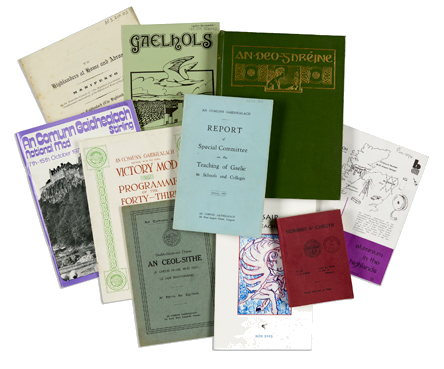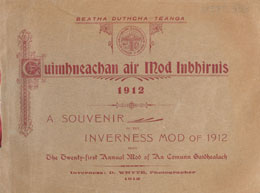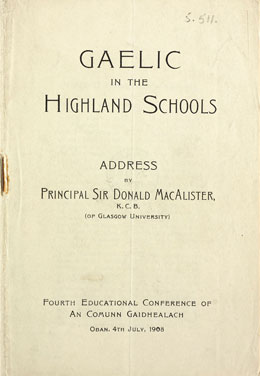An Comunn Gàidhealach

An Comunn Gàidhealach was established in 1891, at a turbulent time for the Gaelic community and language.
Unresolved land rights issues and poverty had led to the Crofters’ War and the formation of the Napier Commission in 1883 to investigate conditions in the Highlands. The Crofters’ Holdings (Scotland) Act of 1886 addressed some of the concerns but problems remained.
The 1872 Education Act had introduced compulsory schooling for 5 - 13 year olds, but this was now to be provided by elected school boards reporting to the Scotch Education Department and as a result the existing Gaelic Society and church schools were closed. There was now no provision for teaching Gaelic and it was often punished if heard in schools.
Other Gaelic societies already existed, such as the Highland Society of London, formed in 1777 and the Gaelic Society of Inverness in 1871. The Lorne Ossianic Society, established in 1872 to promote Gaelic language and culture, held annual Highland Games in Oban which included Gaelic singing competitions. However, it foundered in the 1880’s so some of its leaders formed An Comunn Gàidhealach to maintain this momentum.
Formation of An Comunn Gàidhealach in 1891
The initial suggestion for the name of the new body was ‘Comunn airson Leasachaidh Ceol agus Litreachas nan Gaidheal’, which was to be simplified to ‘The Highland Bardic Association’ in English. This was changed to the simpler ‘An Comunn Gàidhealach’, or ‘The Highland Association’ that we know today. It was initially based in Glasgow, opening an Inverness office in 1963, followed by an office in Stornoway in 1972.

An Comunn established itself with the publication of its ‘Manifesto’, which outlined its objectives. It lists the names of its patrons and office-bearers, who were mostly members of the aristocracy, academics and clergymen, as was common in organisations at the time. This was an age before direct government funding was available for the promotion of Gaelic, which depended instead on donations and the efforts of volunteers.
It listed An Comunn’s five key objectives:
- To promote the cultivation of Gaelic Literature and Music and Home Industries in the Highlands.
- To encourage the Teaching of Gaelic in Highland Schools.
- To hold an Annual Gathering, at which competitions shall take place, and prizes be awarded.
- To publish at intervals a volume of each Prize Composition as may be selected by the Executive Council.
- To raise, by means of members’ subscriptions and of donations, a fund which shall enable the Association to carry out these objects.
These were ambitious and far-reaching objectives, intended to sustain and develop the use of Gaelic. The text is mostly in English, partly because English had to be used to further the cause of Gaelic with a Westminster Government and local officials who only spoke English, but also because not all of An Comunn’s founders could speak Gaelic. However, it concludes in Gaelic with a passionate call to action, a plea as relevant today as in 1891:
‘Do Chlanna nan Gaidheal anns gach cearn’
…’Do Chlanna nan Gaidheal anns gach cearn … Dùisgibh, ma ta, èirichibh agus cuiribh an gniomh. Rugaibh sibh 'n 'ur Gaidheil; 'n 'ur Gaidheil bitheadh sibh; agus togaibh bhur cloinn gu bhi 'n an Gaidheil.’
Translated into English, this is an encouragement:
‘To the children of the Gael in every region’
…’Awake, then, and put this strategy into action. You were born as Gaels, you continue to be Gaels, and you should raise your children to be Gaels’.
Early activities & publishing
Although well known today as the organiser of the Mòd, or Annual Gathering, this was only one of An Comunn’s key objectives when it was established. An investigation of its early activities reveals that all of its objectives were pursued actively, and it lobbied for change on many issues of current and ongoing concern to the Gaelic community, as a reading of its many publications will confirm.
Publishing
Gaelic works were published from the outset, recognising that education and information provision were key means of securing the survival of the language.
Appropriately, An Comunn’s first publication was Scottish Gaelic as a specific subject. Stage 1. 1893. This was published because it was felt that none of the existing Gaelic grammar books were suitable for use in teaching classes.
Childrens’ books, first aid books, books of Gaelic to be sent to comfort soldiers overseas, new writing and plays in Gaelic, not to mention annual Mòd programmes are among the wide variety of titles that An Comunn has published. It continues to publish ‘An Litreachas’ annually, which is a compilation of Mòd award-winning writing.
An Comunn also published a journal continuously from 1905-1970. 'An Deo Gréine' (The Sunbeam), 1905 - 1922, and 'An Gàidheal' (The Gael), 1922 - 1967, with a total of 744 issues between them. Each issue contained articles in Gaelic and in English, which were described as the ‘English Department’ and the ‘Gaelic Department’, but were not translations of each other.
They are rich sources of information on Gaelic and Highland matters, covering both language and policy in all areas. Coverage was very wide and often topical, including reports of meetings, information on the Highland economy and the land issue. For example there is an update on the land holdings being offered under the Sailors and Soldiers (Gifts for Land Settlement) Act, 1916, in Leabhar XIV, Earrann 3, Darna Mìos a' Gheamhraidh, 1918.
The journal format was also a good way to publish new writing, poetry, folklore, information on Gaelic street names, and to record language usage. There is a fascinating series on ‘Gaelic terms expressive of affection and terms of invective’ which ran from October 1916 to September 1918. One example is an explanation of ‘Aireamh na h-Aoine ort!’ in Volume 13, October 1917-September 1918.
The journals even included the School Leaving Certificate Gaelic language exam papers, and of course adverts, which are also a wonderful source of social history.
After ‘An Gàidheal’ ceased in 1967, a newspaper ‘Sruth’ was issued until it was absorbed into the ‘Stornoway Gazette’ in 1970. Many more titles can be found in the National Library of Scotland's Digital gallery.
In 1966 a Gaelic Centre was opened at Culloden, in recognition of the growing tourist interest in Gaelic, and a set of informative leaflets was prepared by experts. As well as traditional areas of history and poetry, they included leaflets on new topics such as Highland hydro-electricity.
Promotion, fundraising & Highland Home Industries

An Comunn’s aptly named 'Propaganda Committee' worked to set up a local branch structure from the outset so that work would reach into communities, and this structure remains today.
A Fèill (or a fair) was held in Glasgow in 1907. This was a popular form of fund-raising at the time, and was organised by Mrs Burnley Campbell, An Comunn’s new President. A cookery book and a compilation of collected writings, ‘Am Bolg Solair’ were published to aid Feill fundraising. The event was a huge success, raising £6,878, and subsequent bazaars followed.
An Comunn also raised significant sums for other national fund-raising campaigns that took place in the 1920’s, for example to build the Northern Hospital in Inverness, and also for the Highlands and Islands Distress Fund, to which they sent £4,949 in 1924, equivalent to around £286,000 today.
Fund-raising was also seen as key to supporting Highland Home Industries and the Highland economy, without which the Gaelic community would inevitably decline.

In 1912 it was reported in the Inverness Mòd souvenir book that a recent sale by the Arts and Industries Committee had raised £500 which was given directly to makers of tweed in the Highlands, a sum which would be in the region of £54,000 today. This was a significant sum for the industry and an example of the quiet, regular fund-raising that was helping the community.
Gaelic education
Concern for the provision of Gaelic education features prominently, and a number of conferences were held. At the fourth conference in Oban in 1908, Sir Donald MacAlister, Principal of Glasgow University and a native Gaelic speaker, outlined the benefits of allowing children to be taught through the medium of Gaelic.

Prior to the 1918 Education Act, An Comunn presented the Westminster Parliament with an 18,000 signature petition to have Gaelic officially recognised. They achieved an amendment whereby the new authorities had to provide ‘adequate provision for teaching Gaelic in Gaelic-speaking areas’, but this was not compulsory, nor was it funded or defined, so was difficult to monitor. Therefore An Comunn appointed a network of local correspondents to monitor the number of Gaelic-speaking members in each authority in order to continue to lobby for change. However this became more difficult with the introduction of a new administrative structure, which created anomalies such as Lewis and Harris being in different educational authorities, meaning that new contacts had to be nurtured. Administrative and boundary changes like this continued to impede campaigns for change.
UHI Ltd (later the University of the Highlands and Islands) was formally established in 1993, but An Comunn identified the need for a university specifically for the Highlands as long ago as 1913, when they put forward a paper proposing a Highland University College. They had identified a pressing need for a Technical College within the Highland boundary, to provide courses to accommodate Highland conditions. Existing agricultural colleges trained students to work as land surveyors, or on large farms, and thus did not prepare them to work on small holdings with mixed stock. Proposals for possible funding sources were drawn up, including government departments and charities. It was also felt that a University College could sit alongside a Technical College, because:
‘more is required in order to completely satisfy the educational wants of the Highlands … The University College would become the embodiment of the higher intellectual aspirations of the free Gaelic spirit’.
However, with war round the corner, this far-sighted proposal came to nothing at the time.
Policy

In 1975 An Comunn published ‘Polasaidh do ‘n Ghàidhlig’ (A Policy for Gaelic), supported by an all-party Parliamentary Gaelic Group. It stated its aim of achieving ‘perfect bi-lingualism in the Gaidhealtachd and of promoting the use of the language in the fringe areas, or the Breac-Ghaidhealtachd’, which it also defined geographically. It also outlined the ‘Fundamental Rights of Gaelic Speakers’ as follows, recognising the growing importance of mass media.
- Right to a full education through the medium of their mother tongue.
- Right to coverage in Gaelic & mass media.
- Right to planned economic development in Gaelic speaking areas.
- Right to deal with local and national governments in Gaelic.
- Right to access the law in Gaelic.
- Right of all Scots to access Gaelic culture.
However the policy also noted that the forthcoming local government re-organisation would present new challenges in achieving these rights because the new boundaries took ‘no account of the traditional linguistic frontier’, a long-standing barrier to achieving change for Gaelic.
The Annual Gathering & An Comunn today
The first gathering, or Mòd as it became known, was held in Oban in 1892. It has been held annually since then, other than during the two World Wars.
An Comunn today

An Comunn works today in a Gaelic environment very different to the one in which it was established. It has campaigned and lobbied for improvement in many aspects of Gaelic life and culture over the past century or so, despite at times being thwarted by changes outwith their control.
However, thanks partly to its own campaigning over the years, there are now a variety of Gaelic organisations devoted specifically to taking forward some of the work that An Comunn undertook in its early days, such as the provision of Gaelic education, music, publishing, land reform, as well as the nurturing of the language itself, all taking place within the context of a National Gaelic Language Plan underwritten by the Gaelic Language (Scotland) Act 2005 (the Act), passed by the Scottish Parliament.
Its objectives are still broad-ranging, and are stated in the An Comunn website. Its aims for Gaelic are more international than at its outset, and at the 2016 Mòd in Stornoway it proposed that Scotland’s political leaders seek UNESCO protection for Gaelic to protect the islands’ ‘living cultural heritage’, a campaign that is ongoing in 2018.
An Comunn is known internationally for its annual Mòd, now a huge flagship event within the Gaelic world and acclaimed for promoting Gaelic language, music and culture, as well as for bringing considerable economic benefit to the host communities.
Further information and reading
The National Library of Scotland holds some of An Comunn’s archival documents, as well as a large collection of An Comunn publications and Mòd programmes.
Many titles can be viewed on the An Comunn section of the Library’s digital gallery. Publications can be also be found on the Library’s catalogue and consulted at the National Library in Edinburgh or Glasgow.
An Comunn’s website has been archived annually since 2013 as part of the UK Legal Deposit web archive, and can be consulted at the National Library in Edinburgh or Moving Image Archive in Glasgow.
For a detailed history see Frank Thompson’s invaluable ‘History of An Comunn Gaidhealach: the first hundred (1891-1991): centenary of An Comunn Gaidhealach’. Published by An Comunn Gaidhealach, 1992.


